What goes into making "the World's best water"? A discussion with Hallstein Water's co-founder
Originally posted in the "Weekend Consumer Blast: What goes into making "the World's best water"? A discussion with Hallstein Water's co-founder". Published on the 13th March, 2019.

We continue to believe strongly that health and wellness is not just a fad and will continue to be an important trend in consumers' minds globally. Although we have heard of better-for-you snacks, no sugar colas, natural toothpaste, pure diapers, unbleached paper towels, etc., most consumers don't spend an enormous amount of time on what makes up 60% of our bodies—water. We believe water is the next focus of consumer health-and-wellness. As part of our Consumer Weekend Blast, we interviewed the cofounder of Hallstein Water, "the world's best water", (and admitted water nerd) Alex Muhr. We hope you enjoy this discussion below (for full disclosure, we've received samples of water from Hallstein...and we love it! Also, responses edited for clarity).
When did you start caring about water so much?
I really started caring about water because of my parents. Back in 1999 around the dinner table, after they learned about how seriously bad drinking juices and sodas are, they told us we had to stop and only drink water instead. As a thirteen-year old you normally don’t want to follow direction so my younger siblings and I had the rebuttal – "why?" If you know my parents, they always want really specific answers backed with a legitimate reason. After sort of just telling us to listen, they jointly realized that, in fact, they did not really know much about water and they said, "we’re going to find the best water" so there is no excuse from us children to have any reason not to drink it. My siblings and I naturally also took an interest that became more intense as the project developed.
My parents began by calling who they thought were experts to tell them which water to buy with scientific reasons. Something that is truly good for you to drink. Those answers were not sufficient for them, especially because how devoid of information water labeling was. Over the next few years, it became a family project, where my parents were learning more and more about drinking water quality by reading up themselves and discussing the parameters with experts. Then we’d discuss those findings as a family—slowly building up our knowledge base and interest in drinking water quality - finding the best for the family.
Why do you care so much about water?
I care about water because it is at the same time probably the most important element of nature, while also being one of the most underappreciated, undervalued, and little understood elements in the world. Leonardo da Vinci once wrote "Water is the driving force in nature." What would the world be without water? What would humanity be without water? What would life itself be without water? There are so many things to think about. Yet it seems that these days, at least in the Western world, it’s one of the most popular topics to pontificate on, and yet so easily taken for granted and misunderstood.
In the rest of the world, there are more than 700 million people who lack easy access to even rudimentary potable drinking water. This holds back the development of those areas drastically. Just think of the hours of productivity lost per day, not to mention the detrimental health effects of waterborne diseases. This is why as part of our company’s mission we want to help organizations that directly have an effect on improving water delivery systems in the third world. Two prime examples are packH2O and Operation Water, which we currently support.
What analytically makes a good water? How did you find that/what proof do you have?
That’s not an easy question to answer; there are no sound-bites here. It’s not possible to say that just on one parameter alone one water is better than another. You have to look at many different parameters together, and after looking at a lot of them, we were able to distill them down to the core metrics that we call the Hallstein Octagon.
Let’s begin with pH1 . At its core, the idea of consuming something alkaline, with a high pH, is to avoid inflammation. We began looking at what the easiest way would be for the family to begin avoiding inflammation, which is oftentimes caused by consuming excessive amounts of carbonated soft drinks, which are high in sugar. These days pH is misunderstood marketing jargon. While the idea of an alkaline diet is generally a good one, just drinking a water with a high pH does not magically cure ills or negate an acidic diet. At the same time, since your blood’s neutral pH is between 7.35-7.45 on the scale you’re not able to negate anything even if you tried with something below that. Since there is research to support that a higher pH water can be beneficial in avoiding inflammation in the body we added it to the list. Because the pH scale is logarithmic, you also don’t want something too high that could also cause harm, sp we decided to search for a water that had results between 8-9.5.
As a second parameter, we need to look at sodium. This is mainly because a water’s pH can be highly influenced by its mineral (aka electrolyte) content, including sodium, as well as calcium, magnesium, and others. Since we already consume sodium through foods, there would be no good reason to drink extra amounts, especially when they are excessive. Water companies have figured out that it’s very easy to boost the pH value by adding electrolytes, especially sodium, to water. Therefore, we wanted to look for a water that had very low amounts of sodium, ideally less than 1 mg/liter.
So really you want to look at pH and sodium in tandem.
Next, we researched a parameter called dissolved oxygen. At a basic level D.O. can signal a water’s purity. This cannot be achieved by adding oxygen to water. When a water molecule is formed it has a maximum saturation level of D.O. at a given temperature. This decreases as it’s exposed to certain things like organic material, nitrates or minerality that oxidize these 1 For those too far removed from Chemistry 101, we remind readers that pH is a scale of acidity from 0 (acidic) to 14 (alkaline), with a pH of 7 indicating a neutral substance. additional oxygen molecules out of the water. D.O. can only be measured at the source and is something that most water companies do not report at all. The positive effect of having a higher level in a water is that it can enhance the taste of consuming food and drink - giving a feeling of freshness. This is also due to the next parameters, in combination. Some research also suggests that higher D.O. can lead to improved recovery times after physical exertion. Our goal was to find a water with D.O. at the source that’s greater than 10 mg/liter.
Nitrates are generally very bad for your health to consume, although the EPA & FDA have extremely generous limits at 10 mg/liter. This is even after filtration and treatment techniques are applied! We decided to look for a water that would come in at less than 3 mg/liter directly at the source.
Similar to nitrates and D.O., the level of total organic carbon can be seen as a signal of natural purity of a water. The higher the level, the increased risk that bacteria are able to form in a water. We found that T.O.C. levels in drinking water should be at most 0.15 mg/liter naturally to reduce the risk of contamination. As a comparison, many municipal water sources target a T.O.C. level of below 2 mg/liter - after filtration and treatment.
We looked for something high in D.O. but very low in naturally occurring nitrates, and extremely low in T.O.C.—something that water experts are truly astounded by.
Total dissolved solids (T.D.S.) is generally a required parameter that companies need to disclose on a bottle label. Put simply, when you evaporate an amount of water at 180 deg C you’re left with a certain amount of minerals. This is measured to get the overall T.D.S. measured in mg/liter of water. You don’t want it to be too low (distilled water is technically zero T.D.S., something you want to put in your iron or clean microchips with) because that will, over a short period, begin to pull minerality from your body. When T.D.S. is too high, you begin depositing minerals in your body. So you’re looking for a happy medium, which is why we searched for a water that would fall between 50-250 mg/liter.
When you look deeper at T.D.S., you encounter electrolytes calcium and magnesium. What’s interesting is that your body can best absorb calcium when it’s in a 2 to 1 ratio with magnesium measured in mg/liter. Waters that purport to have added calcium are often even at 10:1 ratios or more, completely useless to your body. So we searched for a water with this 2:1 ratio.
Lastly, we looked at exit temperature to determine a water’s potential for contamination. This is another parameter that many water brands do not disclose. When a water exits the ground above 7 deg C (some even come out almost boiling!)—the likelihood that it’s not only chock-full of minerals but also harbors bacteria already is almost guaranteed. This is obviously something you don’t want, so we decided to look for water that exits consistently below 7 deg C / 45 deg F. This is sometimes called "glacial" water.
The following are brief, but no less important secondary parameters:
- Deep well: In looking for a well or source that is deeper than 100 meters, you are trying to find a water that has a lower likelihood of being contaminated. Whether by bacteria or by man-made contaminants from industry or agriculture. This isn’t to say a deep well can't have those harmful components, because deep wells also need other geological protective formations, but it’s a good indicator.
- Filled cold: Many water companies will heat up water to be able to fill bottles more securely and with less contamination risk in the filling process. We wanted to be able to fill our water aseptically, which means cold. This is much more expensive to do.
- No pumping: What you’re looking for is a water that comes from a truly artesian source that does not require additional pumping from the well or spring source, due to geologic considerations. Pumping, especially when it’s excessive or required, has the high likelihood of changing the water quality over time, which is an unacceptable risk for us.
- No Treatment and/or Filtration: The need for filtration techniques or chemical treatment necessarily indicates that the water is unsuitable for drinking naturally. This is not something we want to put in our bodies.
The results after defining the quality parameters and searching globally with multiple geological teams: A typical quality report shows that Hallstein comes in at a pH of 8.3, 0.15 mg/l of Sodium, 10.8 mg/l of D.O., 1.83 mg/l of Total Nitrates, 0.09 mg/l of TOC, 84 mg/l of TDS, a 2:1 Ca:Mg Ratio, and 5.6 deg Celsius. The secondary parameters include that Hallstein comes from a well depth of over 214m/700ft deep, is filled cold, and is not pumped, treated or filtered.
Is there really a difference in waters out there?
Many people say "water is water" or "water is just H2O". They are woefully misinformed. In our database (Exhibit 1) you can see how drastically different waters actually are on many different parameter levels. Two water sources just miles apart may have completely different pH, sodium levels, TOC amounts, exit temperatures, potential contaminants, etc. All this affects how the water could potentially be bottled, how it may need to be filtered, treated and so forth, which in the end can have an impact on the human body.
How do some popular waters test along those metrics?
You've tested many hundreds of waters. Can you share some of that data with our readers? The fact is that most, if not all waters are what some might call a "chemical cocktail". This really means that they are mechanically or chemically treated and often times both are applied. See Exhibit 1 for a comparison of key metrics.
EXHIBIT 1: Hallstein's water comparison vs. other U.S. waters
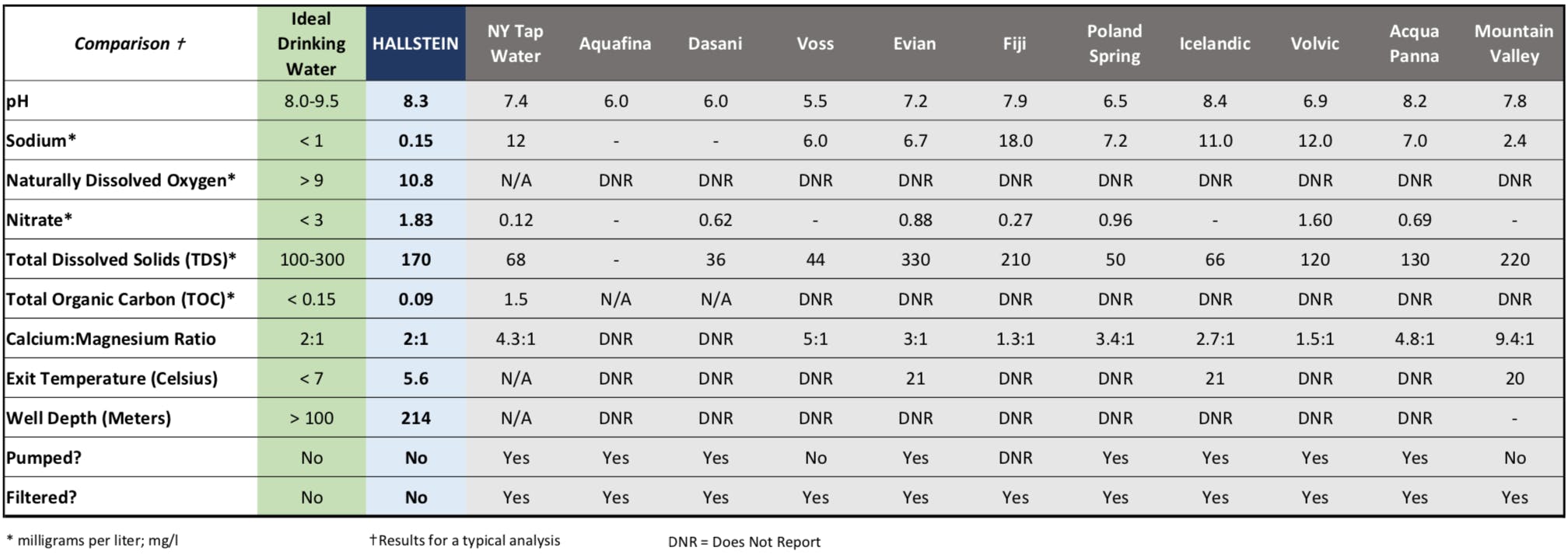
Source: Bernstein interviews, Hallstein Water
Can you feel the difference when you drink good or bad water? How?
In my opinion, and we definitely hear the same from our clients, put simply, Hallstein makes you feel more hydrated. Of course taste has a lot to do with that. The best way you can test how a water may taste different is by drinking it at room temperature. Especially when comparing waters, room temperature will really accentuate differences. Often water will be served cold, or over ice, to mitigate any tastes of extreme minerality, chemical treatment, or plastic taste from a bottle. Many of our clients say they feel the difference after having tried Hallstein for longer than a week or two. Those who suffer from acid reflux or migraines have the strongest positive feedback currently.
Why is the name "Hallstein"?
"Hallstein" is the combination of the town and culture of Hallstatt in the Inner Salzkammergut in Austria and the Dachstein, which is the name of the mountain that exactly defines our catchment area, meaning we know that Hallstein can only come from falling and then naturally filtering through the mountain itself to the aquifer. (Exhibits 2-3)
EXHIBIT 2: Hallstein Water's origin
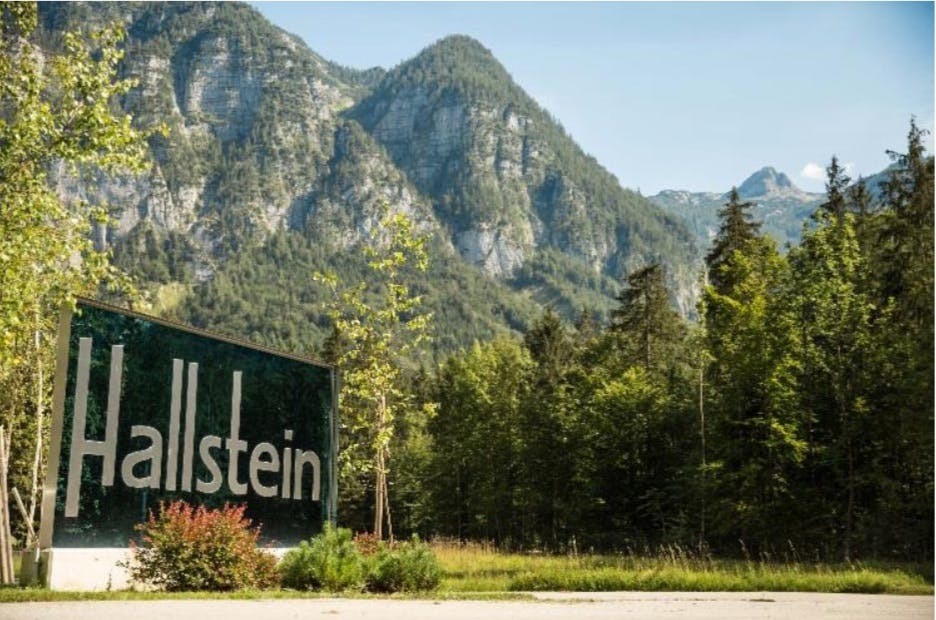
EXHIBIT 3: Hallstatt, Austria
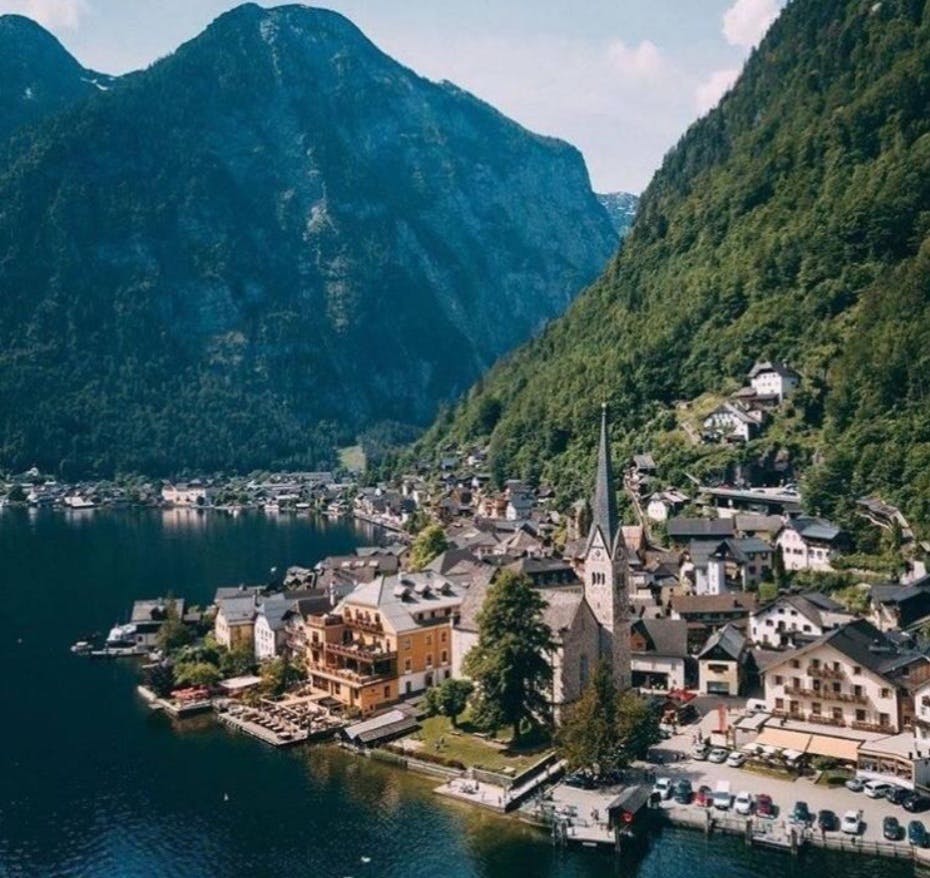
What were some of the biggest hurdles in harvesting Hallstein Water?
Given that we do not pump, treat or filter Hallstein, that proved to be a challenge in building a filling process that could accommodate our requirements while minimizing the potential for contamination. Our ultimate goal was to construct a process that would not disturb the aquaculture below our feet and ensure we keep a naturally replenishing, i.e., sustainable source. Therefore, we had to build a system which uses all food-grade stainless steel in the filling process, and that is welded end to end. (Exhibit 4)
In the beginning the hurdles were all about permitting, which took almost 10 years to complete, although now some of it happens concurrently. There were a number of political challenges which delayed the project for some time.
Lastly, since we will only ever be available to a limited client base globally, the potential for growth is stunted. This is fine with us, however, because we’re seeing that a community is forming around Hallstein where our clients can gather and appreciate quality products and experiences together.
EXHIBIT 4: Hallstein bottling line
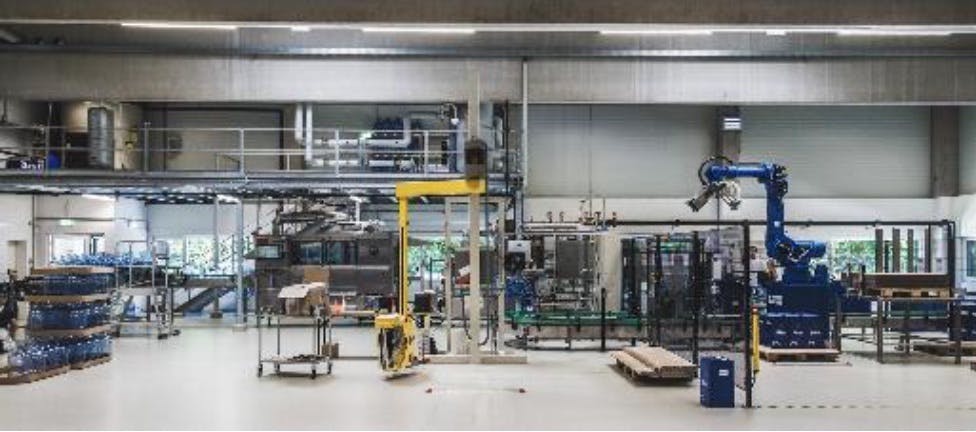
Why can’t we manufacture good water, like through reverse osmosis or boiling or ultra-filtering or something else?
To answer this question, you first need to define what "good" means, which is what we think we did based on our search for the best. By its nature, the manufacturing of a water would make it not fully natural. Even if eventually there is a technological revolution that could exactly replicate Hallstein’s molecular makeup—, which we would applaud—it would still be an engineered product. For the benefit of global consumption and not needing to worry about contaminants, that would be a massive improvement. In fact, it’s already possible to do that with wine, but if you appreciate when nature produces something of truly high quality, then there is no substitute.
Why don’t you pump the water?
Pumping the water out of our aquifer has the potential to disturb the pristine aquaculture that exists at depth. This becomes almost guaranteed when there is excessive pumping, not to mention the possibility that the actual valley floor may sink, like in the central valley of California. Just imagine what is happening underground. At a basic level, underground, there is water in many places and the interaction of the different rock sheets are creating pressure to keep other water at bay. Pumping increases the risk that this pressure reverses or begins to "turn" the aquifer, which lets lesser quality water encroach, or pulls up ancient brackish water from extreme depths to completely contaminate the aquifer’s water quality. This is a risk we are not willing to take.
How do you ship it? In what?
Currently we only ship in 5-gallon sized Tritan Co-polyester bottles (see Exhibit 5). Some people are surprised that we would use plastic, but we wanted a material that first and foremost does not affect Hallstein’s water quality. After that we were looking for something that is practical to ship and highly recyclable. We box every bottle in corrugated cardboard and palletize 64 bottles at a time. We constantly test if the quality changes after bottling, and after transport—it doesn’t.
EXHIBIT 5: Hallstein 5-gallon water bottle
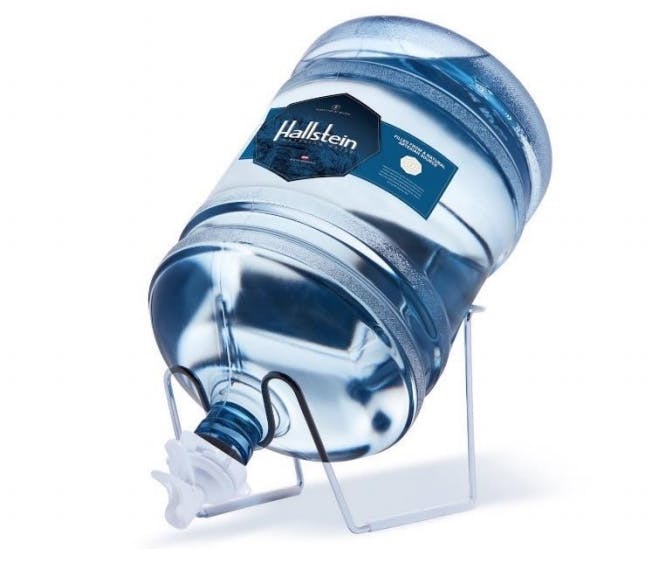
We do actually have a plan to offer single-use smaller (recycled) glass bottles by Q1'20. There is a lot of demand from our current clients.
From the source in Austria, we ship via land freight across Europe and then sea freight to the US across a 3PL’s logistics hubs. For the last mile, we use UPS (North America), DHL (Continental Europe) and Parcelforce (UK). As we expand the footprint globally we will work with local last mile providers to integrate and be able to track every bottle from the source to our clients.
There are other solutions we are looking at to close the loop further in terms of being able to recycle the Tritan bottles, which include more efficient logistics in higher density areas.
Are you concerned about the environmental cost of shipping the water, and or your extraction process?
At our core, to protect the longevity of our source, we are focused on sustainability. Our primary focus is that the aquifer itself is totally sustainable. Beyond that, we analyzed all the potential delivery methods and found that the 5-gallon Tritan Co-polyester bottle is currently the best solution available. We’re also exploring a smaller bottle option for our clients that uses a thinner recycled glass bottle. In the long run we want to do what it takes, in an economic and practical way, to be as sustainable as we possibly can. Therefore, we’re not concerned about the environmental cost of shipping water.
How much does your water cost to your customers?
Currently we only deliver in 5-gallon bottles. We aim to keep the pricing as simple as possible. For the United States, Canada, Mexico and the Caribbean we price at US$100 per bottle, not including applicable sales taxes and/or import fees or tariffs. Shipping is included. For the UK, Europe, Middle East and rest of world, we price at €100, not including applicable sales taxes and/or import fees or tariffs. Shipping is generally included, except in very specific cases where there are surcharges. (See Exhibit 6 for a pricing comparison of Hallstein and common U.S. water brands)
Who buys your water?
Our clients are by and large ones that appreciate true quality and appreciate the benefits of Hallstein, whether for its potential in alleviating acid reflux or for enhancing their wine consumption experience. We sell direct-to-consumer through our website www.hallsteinwater.com. Our water has been served in foodservice, particularly high-end hotels and restaurants, including Michelin-starred Wallsé and Gabriel Kreuther in New York City.
Who do you consider your competitors, if there are any?
On the one hand, every non-alcoholic beverage out there is a competitor of ours. We’re competing against "tasty" products like juices and sodas. Specifically in the water category, there are brands that position themselves as higher end. Then there are those that position themselves as healthier. When you go deeper into it, we don’t believe we have a true equal in competition because most brands take advantage of the lack of transparency and knowledge gap consumers have in truly understanding the marketing jargon that they’re consuming.
EXHIBIT 6: The cost of Hallstein's Water is meaningfully higher compared to other brands

Note: Hallstein price includes shipping. Source: Nielsen xAOC + Convenience for 12 Weeks Ended 2/9/19, Hallstein Water, Bernstein analysis
Although carbonation would defeat some of the benefits of the product, would you ever consider sparkling Hallstein to reach a broader audience?
Like you mention, we feel that it defeats the special qualities of Hallstein. Therefore, for those consumers who are adamant about having a sparkling product, there are many home appliances out there that can add carbonation to still liquids. But we think consumers should at least use a high-quality base water to start, if they're going to do it!
Where do you want to go from here with Hallstein? What would be success in 5 years?
We’re optimistic that while not being able to serve everyone, we at Hallstein will also shine a light on improving drinking water globally. This means improving standards in the Western world to the point where contaminants in water produced by industry or pharma are filtered out of the drinking water, among other drastic standard improvements. For the rest of the world that does not enjoy easy access to even semi-potable drinking water, we want to be supporting initiatives like Operation Water and PackH2O that are working to build infrastructure and alleviate daily problems. Freeing up those many millions of people’s daily capacity will unlock a lot of potential around the world for economic prosperity and general good. We want to be a part of that.
Copyright 2019, Sanford C. Bernstein & Co., LLC, Sanford C. Bernstein Limited, Sanford C. Bernstein (Hong Kong) Limited 盛博香港有限公司, and AllianceBernstein (Singapore) Ltd., subsidiaries of AllianceBernstein L.P. ~1345 Avenue of the Americas ~ NY, NY 10105 ~212/756-4400. All rights reserved.
This publication is not directed to, or intended for distribution to or use by, any person or entity who is a citizen or resident of, or located in any locality, state, country or other jurisdiction where such distribution, publication, availability or use would be contrary to law or regulation or which would subject Bernstein or any of their subsidiaries or affiliates to any registration or licensing requirement within such jurisdiction. This publication is based upon public sources we believe to be reliable, but no representation is made by us that the publication is accurate or complete. We do not undertake to advise you of any change in the reported information or in the opinions herein. This publication was prepared and issued by Bernstein for distribution to eligible counterparties or professional clients. This publication is not an offer to buy or sell any security, and it does not constitute investment, legal or tax advice. The investments referred to herein may not be suitable for you. Investors must make their own investment decisions in consultation with their professional advisors in light of their specific circumstances. The value of investments may fluctuate, and investments that are denominated in foreign currencies may fluctuate in value as a result of exposure to exchange rate movements. Information about past performance of an investment is not necessarily a guide to, indicator of, or assurance of, future performance.
